Table of Contents[Hide][Show]
- Nutrivore Score for Muscadine Grapes – 644
- Muscadine Grape Nutrition Facts
- Grape Nutrition Varies With Processing
- Grape Nutrition Varies With Variety
Health Benefits of Muscadine Grape Nutrients+−
- Muscadine Grapes Provide 258% DV Vitamin B2 (Riboflavin)
- Muscadine Grapes Provide 192% DV Manganese
- Muscadine Grapes Provide 1047.1 mg of Polyphenols
- Muscadine Grapes Provide 2.0 mg of CoQ10
- Muscadine Grapes Provide 8.7 g of Fiber
- Muscadine Grapes Provide 30% DV Copper
- Muscadine Grapes Provide 27% DV Vitamin K
- How Much Muscadine Grapes Should We Eat Per Day?
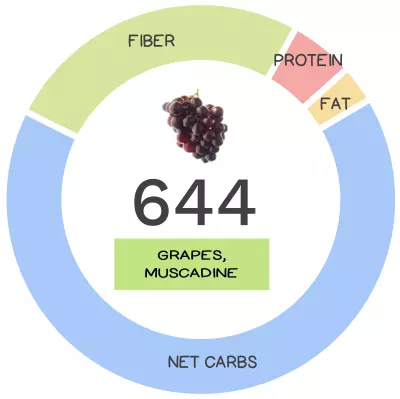
Grapes have been cultivated for around 8,000 years and have been eaten in both fresh and dried forms (i.e. raisins, sultanas, currants) throughout history. One of the most notable uses for grapes in both present times and throughout history, is in the production of wine. Other varieties of grape products have places in many different cuisines throughout the world including oils, jam and preserves, juice, and vinegars.
Grapes played a significant role in the invention of alcohol, as yeast was one of the earliest microorganisms that was used in fermentation, and it occurs naturally on the skin of grapes. This discovery has let cultures produce (and consume…yum!) wine for thousands of years across many global cultures.
Alcohol fermentation was discovered thanks to grapes! The natural yeast found on grape skins was used in the earliest fermentation and production of wine.
Grapes are small and spherical or oval shaped, and they typically grow in clusters ranging from 15 to 300! They grow on vines and are commonly cultivated in large quantities on vineyards or orchards. They can be found in a large variety of colors including dark blue, green, black, crimson, orange, pink, yellow, and even some purple hues. There are specific nutrients- most notably anthocyanins and polyphenols- that are responsible for the varying shades of grapes, and consequently any differing shades of wine that might result from fermentation.
Though the majority of the world’s grapes are used to make wine (about 71%!!), a healthy 27% is typically consumed as fresh fruit, and a further 2% are consumed dried. These statistics lead to the classification of grapes as being either table or wine grapes. While there are no formal records that break down the global grape production by their specific variety, it is estimated that the most widely cultivated and consumed variety is the Thompson Seedless grape, otherwise known as the sultana.
Grapes are generally classified as “wine grapes” or “table grapes” and each has slightly different qualities such as skin thickness, and sweetness level.
Wine grapes are usually selected for their thick skins, as this is where most of the aroma of wines is derived from. They are usually sweeter also, as they are harvested during their peak sugar levels (about 24% by weight.) Table grapes on the other hand are usually harvested when they have sugar content of 15% by weight.
Table grapes usually are somewhat larger than wine grapes and have a thinner skin which makes them easier to eat and use for cooking purposes. These grapes are often cultivated for their seedless varieties as it offers a much more pleasant eating experience. However, seedless varieties may be missing out on some phenomenal phytonutrients as the seeds are where many beneficial nutrients are found!
Grapes notably have a very impressive phytonutrient known as resveratrol, which is infamous for its prevention of aging, anti-inflammatory, and antioxidant properties. Resveratrol is also known to show benefits for prevention of cancer, as well as offer cardio-protective and neuro-protective effects, in addition to being beneficial for diabetes, liver disease, obesity, Alzheimer’s disease and Parkinson’s disease.
Let’s dive into the juicy details of this fruit that’s jam-packed with both deliciousness and nutrients!
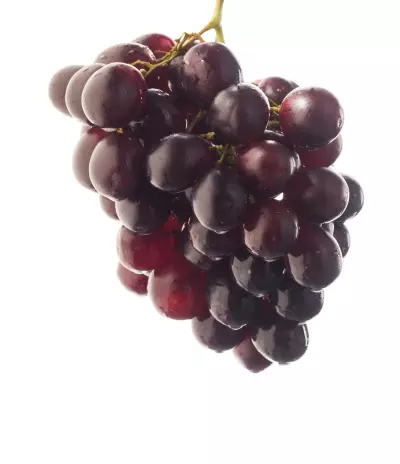
Nutrivore Score for Muscadine Grapes – 644
Muscadine grapes have a Nutrivore Score of 644, making them a high nutrient-dense food! Plus, they are a low-fat food; muscadine grapes have 1.1 grams of fat per 1-cup serving!
Per serving, muscadine grapes are a best source (>50% daily value) of manganese, polyphenols, and vitamin B2 (riboflavin); an excellent source (20-50% daily value) of copper, coQ10, dietary fiber, and vitamin K; and a good source (10-20% daily value) of potassium, vitamin B1 (thiamin), vitamin B6 (pyridoxine), vitamin B7 (biotin), and vitamin C.
Ditch Diets. Embrace Nutrients. Start with These 5 Free Guides.
Sign up for the free weekly Nutrivore Newsletter and get 5 high-value downloads—delivered straight to your inbox—that make healthy eating simple and sustainable.

Muscadine Grape Nutrition Facts
One serving of muscadine grapes is standardized to 1 cup or about 244 grams (8.6 ounces). One serving of muscadine grapes is roughly equivalent to 37 grapes.
Muscadine Grape Nutrition Facts Per Serving
| Grapes, muscadine, raw | Nutrivore Score: 644 | Nutrient Density: High |
|---|---|---|
| Serving Size: 1 cup (224 grams) | Protein: 1.8 grams | Net Carbohydrates: 22.5 grams |
| Calories: 128 | Total Fat: 1.1 grams | Dietary Fiber: 8.7 grams |
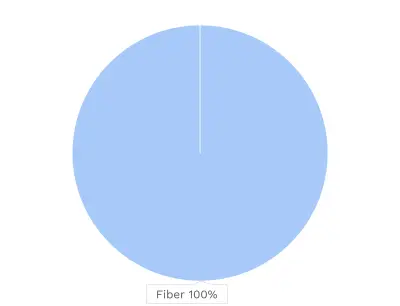


| VITAMINS | ||
|---|---|---|
| Vitamin A | 6.7 μg RAE | 1% DV |
| Vitamin B1 (Thiamin) | 206.1 μg | 17% DV |
| Vitamin B2 (Riboflavin) | 3360.0 μg | 258% DV |
| Vitamin B3 (Niacin) | 0.7 mg | 4% DV |
| Vitamin B5 (Pantothenic Acid) | 0.1 mg | 1% DV |
| Vitamin B6 (Pyridoxine) | 246.4 μg | 14% DV |
| Vitamin B7 (Biotin) | 3.6 μg | 12% DV |
| Vitamin B9 (Folate) | 4.5 μg | 1% DV |
| Vitamin B12 (Cobalamin) | 0.0 μg | 0% DV |
| Vitamin C | 14.6 mg | 16% DV |
| Vitamin D (D2 + D3) | 0.0 μg | 0% DV |
| Vitamin E | 0.4 mg | 3% DV |
| Vitamin K | 32.7 μg | 27% DV |
| Choline | 12.5 mg | 2% DV |
| Myo-Inositol | 35.8 mg | ~ |
| CoQ10 | 2.0 mg | ~ |
| FUNCTIONAL FATS | ||
|---|---|---|
| MUFA | 0.0 g | 0% DV |
| ALA | 53.8 mg | 3% DV |
| EPA + DHA | 0.0 mg | 0% DV |
| CLA | ~ | ~ |
| Linoleic Acid | 0.2 g | 1% DV |
| MCT’s | ~ | ~ |
| MINERALS | ||
|---|---|---|
| Calcium | 82.9 mg | 6% DV |
| Copper | 266.6 μg | 30% DV |
| Iodine | ~ | ~ |
| Iron | 0.6 mg | 3% DV |
| Magnesium | 31.4 mg | 7% DV |
| Manganese | 4419.5 μg | 192% DV |
| Phosphorus | 53.8 mg | 4% DV |
| Potassium | 454.7 mg | 10% DV |
| Selenium | 0.2 μg | 0% DV |
| Sodium | 2.2 mg | 0% DV |
| Zinc | 0.2 mg | 2% DV |
| PHYTONUTRIENTS | ||
|---|---|---|
| Carotenoids | 235.2 μg | ~ |
| Polyphenols | 1047.1 mg | ~ |
| Phytosterols | 44.8 mg | ~ |
| Glucosinolates | ~ | ~ |
| Thiosulfinates | ~ | ~ |
| Betalains | ~ | ~ |
| AMINO ACIDS & PEPTIDES | ||
|---|---|---|
| Taurine | ~ | ~ |
| Ergothioneine | ~ | ~ |

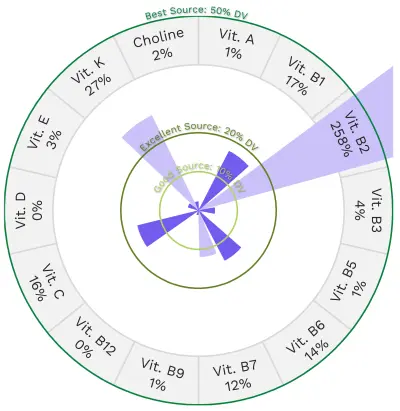

Grape Nutrition Varies With Processing
The Nutrivore Score of grapes varies based on method of preparation and processing. Grapes are consumed in numerous ways such as in grape juice, jams, jellies, and dried as raisins. Typically raisins come from Thompson seedless European varieties that have been dried in the sun, oxidizing and caramelizing the fruit’s natural sugars and resulting in the characteristic dark brown or black color.
| NUTRIVORE SCORE | |
|---|---|
| Grape juice, canned or bottled, unsweetened | 110 |
| Muscadine grapes, raw | 644 |
| Raisins, dark, seedless | 106 |
| Raisins, golden, seedless | 103 |
| Raisins, seeded | 114 |
Grape Nutrition Varies With Variety
There are numerous types of grapes, varying with respect to color, flavor, seeds, size, skin-type, sugar content, and nutrient profile which means their Nutrivore Scores also vary. Muscadine grapes are native to North America and include Higgins, Jumbo, and Roanoke varieties.
| NUTRIVORE SCORE | |
|---|---|
| European grapes, red or green (ex Thompson seedless), raw | 271 |
| Muscadine grapes, raw | 644 |
| Slip skin (American type) grapes, raw | 365 |
Impressed muscadine grapes are jam-packed with nutrients? Maybe your friends will be too!
Health Benefits of Muscadine Grape Nutrients
Let’s take a closer look at all of the best and excellent source of nutrients found in a 1-cup serving of muscadine grapes and see how they benefit our health.
Muscadine Grapes Provide 258% DV Vitamin B2 (Riboflavin)
Muscadine grapes are a best source of vitamin B2 (riboflavin), providing an impressive 258% of the daily value per 1-cup serving!
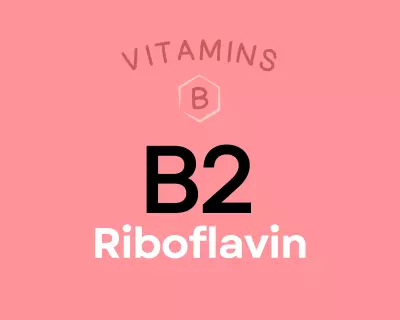
Riboflavin (or vitamin B2) is a vitamin that helps form two important coenzymes involved in oxidation-reduction reactions: flavin mononucleotide (FMN), and flavin adenine dinucleotide (FAD). Collectively, these coenzymes are involved in antibody production, energy production, growth and development, skin and hair health, and the metabolism of several other nutrients (vitamin B6, niacin, folate, and iron). Research suggests a role for riboflavin in preventing or treating migraine headaches, cardiovascular disease, cataracts, and preeclampsia during pregnancy. It also possesses some anti-cancer properties due to its involvement in folate metabolism and MTHFR activity. Learn more about vitamin B2 here.
Muscadine Grapes Provide 192% DV Manganese
Muscadine grapes are also a best source of manganese, providing 192% of the daily value per 1-cup serving!

Manganese is an essential mineral that serves as a cofactor and component of numerous enzymes. Through these roles, it’s involved in carbohydrate metabolism, amino acid synthesis, gluconeogenesis, detoxification, lipid processing, free radical defense, bone and collagen formation, and wound healing. Although the research so far is limited, some evidence suggests that manganese can protect against osteoporosis and diabetes, and may even be involved in seizure disorders. Learn more about manganese here.
Muscadine Grapes Provide 1047.1 mg of Polyphenols
Muscadine grapes are a best source of polyphenols, providing 1047.1 mg of polyphenols per 1-cup serving!

Polyphenols play a huge role in protecting against cancer, heart disease, diabetes, asthma, osteoporosis, neurodegenerative diseases, and other conditions associated with oxidative stress. In fact, a major reason foods like red wine and olive oil (as well as diets rich in both, such as the Mediterranean diet) show up as so beneficial may be due to their high polyphenol content! Along with chronic diseases, supplementing with polyphenols has been shown to protect against infections and reduce the signs of aging. Polyphenols exert their most potent effects by acting as antioxidants—preventing cellular damage by neutralizing hazardous oxygen radicals and improving cellular health as a result (which, in turn, benefits virtually every system in the body). As a result of their antioxidant properties, polyphenols also boost the immune system and protect against both chronic and acute diseases. In addition, polyphenols can help regulate enzyme function, stimulate cell receptors, modulate the functions of inflammatory cells (including T and B lymphocytes, macrophages, platelets, and natural killer cells), alter adhesion molecule expression, affect nerve cells and cardiac muscle cells, and exert antiviral effects. Learn more about polyphenols here.
Muscadine Grapes Provide 2.0 mg of CoQ10
Muscadine grapes are an excellent source of coQ10, providing 2.0 mg of coQ10 per 1-cup serving!
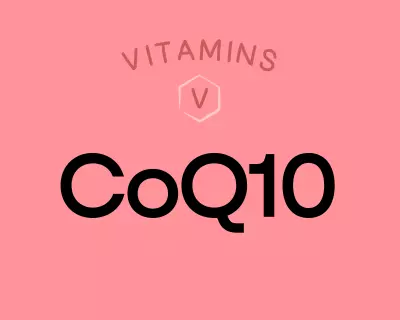
Ubiquinone is the oxidized form and ubiquinol is the reduced, more bioavailable form of the vitaminlike compound coenzyme Q10 (coQ10). CoQ10 is a potent antioxidant and a cofactor in the electron transport chain for the production of ATP. It may be helpful in treating or preventing heart and blood vessel conditions, diabetes, gum disease, muscular dystrophy, chronic fatigue syndrome, and breast cancer. Sources include beef, pork, mackerel, yellowtail fish, and chicken; it’s also found in smaller amounts in vegetables like broccoli and herbs like parsley. Learn more about coQ10 here.
Muscadine Grapes Provide 8.7 g of Fiber
Muscadine grapes are also an excellent source of dietary fiber, providing 8.7 g of fiber per 1-cup serving!

Fiber serves as substrate for the trillions of microbes that inhabit our digestive tracts, collectively referred to as the gut microbiome. Through their metabolism of fiber, these resident microbes benefit us in a whole host of ways, including aiding digestion, vitamin production, detoxification, regulation of cholesterol metabolism, providing resistance to pathogens, immune regulation, neurotransmitter regulation, regulation of gene expression, and more! In fact, every human cell is impacted by the activities of our gut microbes. A healthy gut microbial community is essential for our health. And, the converse is also true: An aberrant gut microbiome has been linked to conditions as wide-ranging as cancer, obesity, diabetes, cardiovascular disease, anxiety, depression, neurodegenerative diseases, autism, autoimmune disease, ulcers, IBD, liver disease, gout, PCOS, osteoporosis, systemic infections, allergies, asthma, and more!
Fiber has other benefits, like regulating peristalsis of the intestines (the rhythmic motion of muscles around the intestines that pushes food through the digestive tract), stimulating the release of the suppression of the hunger hormone ghrelin (so we feel more full), and slowing the absorption of simple sugars into the bloodstream to regulate blood sugar levels and avoid the excess production of insulin. Fiber also binds to various substances in the digestive tract (like hormones, bile salts, cholesterol, and toxins) and, depending on the type of fiber, can facilitate either elimination or reabsorption (for the purpose of recycling, which is an important normal function for many substances like bile salts and cholesterol), both of which can be extremely beneficial—if not essential—for human health.
The recommended dietary intake for fiber is 14 grams per 1000 kcal, which translates to 28 grams of fiber, if you eat a 2,000 calorie per day diet. However, there are many studies showing greater benefits from even higher levels of intake. Lear more about fiber here.
Muscadine Grapes Provide 30% DV Copper
Muscadine grapes are an excellent source of copper, providing 30% of the daily value per 1-cup serving!

Copper is a trace mineral that’s essential for all living organisms. Copper serves as a component of numerous enzymes and proteins in the body, giving it diverse roles in the growth, development, and maintenance of various organs (including the heart and brain), bone, and connective tissue. Copper is also involved in glucose and cholesterol metabolism, helps regulate gene expression, can scavenge free radicals, and is needed for the production of red blood cells. Learn more about copper here.
Muscadine Grapes Provide 27% DV Vitamin K
Muscadine grapes are also an excellent source of vitamin K, providing 27% of the daily value per 1-cup serving!
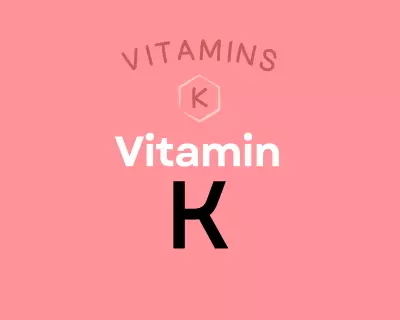
Vitamin K is actually a group of fat-soluble vitamins with a similar molecular structure, existing as K1, multiple isoforms of K2, and the synthetic form K3. This nutrient plays a vital role in coagulation, due to serving as a cofactor for proteins needed for blood clotting; it’s also essential for bone metabolism, cellular function, and the prevention of soft tissue calcification. Getting enough vitamin K2 can help protect against cardiovascular disease, may improve bone mineral density and skeletal health, and may even support endocrine function and brain health; there’s also some limited evidence it has anti-cancer and anti-inflammatory properties. Learn more about vitamin K here.
Learn What Foods Are the Best Sources of Every Nutrient

The Top 25 Foods for Every Nutrient
The Top 25 Foods for Every Nutrient e-book is a well-organized, easy-to-use, grocery store-friendly guide to help you choose foods that fit your needs of 43 important nutrients while creating a balanced nutrient-dense diet.
Get two “Top 25” food lists for each nutrient, plus you’ll find RDA charts for everyone, informative visuals, fun facts, serving sizes and the 58 foods that are Nutrient Super Stars!
Buy now for instant digital access.
How Much Muscadine Grapes Should We Eat Per Day?
Grapes aren’t just bunches of fun to eat, they are jam-packed with nutrients as well!
Eating two or three servings of fruit per day is optimal from a health perspective. A 2017 systemic review and meta-analysis looked at how all-cause mortality was impacted by varying intakes of 12 different food groups: whole grains and cereals, refined grains and cereals, vegetables, fruits, nuts, legumes, eggs, dairy products, fish, red meat, processed meat, and sugar-sweetened beverages. This analysis revealed non-linear relationships between how much of a particular food group we eat and how it impacts our health. While the results revealed no upper limit to the benefits of vegetable intake, the sweet spot for fruit intake was 300 grams daily. Intakes of fruit over 400 grams per day were not as beneficial as 300 grams, but the good news is that even intakes of 600 grams of fruits per day was superior to no fruit at all! This sweet spot for fruit intake translates to 2 to 3 servings of fruit daily.
And a 2018 review similarly concluded that two to three servings of fruit daily was optimal for reducing risk of cardiovascular disease, type 2 diabetes, obesity, chronic obstructive pulmonary disease, chronic constipation, and inflammatory bowel disease.
Fruit makes a convenient snack, a healthy dessert, a whimsical addition to salads, and a sophisticated flavoring agent in the form of salsas, jams, and chutneys. A serving is standardized to 1 cup chopped for raw vegetables and fruits (typically translates to 1/2 cup to 2/3 cup once cooked). Learn more in Importance of Vegetables and Fruit
It’s always best to mix up the fruits and veggies you eat day to day (aiming for a wide variety of different vegetables and fruits throughout the week), and grapes definitely have a place at the table.
Easily track your servings of Nutrivore Foundational Foods!

The Nutrivore Weekly Serving Matrix
The Nutrivore Weekly Serving Matrix digital resource is an easy-to-use and flexible weekly checklist designed to help you maximize nutrient-density and meet serving suggestions of Nutrivore foundational foods, all without having to weigh or measure your foods!
Includes a 22-page instructional guide and downloadable interactive guides.
Buy now for instant digital access.
cITATIONS
Expand to see all scientific references for this article.
Boreková M, Hojerová J, Koprda V, Bauerova K. Nourishing and Health Benefits of Coenzyme Q – a review. Czech J. Food Sci. 2008. Vol 26 (4):229-241.
Clements RS Jr, Darnell B. Myo-inositol content of common foods: development of a high-myo-inositol diet. Am J Clin Nutr. 1980 Sep;33(9):1954-67. doi: 10.1093/ajcn/33.9.1954. PMID: 7416064.
Phenol-Explorer: Fox grape [Black]
Piironen V, Toivo J, Puupponen-Pimia R, Lamp AM. Plant sterols in vegetables, fruits and berries. Journal of the Science of Food and Agriculture. 2003. Vol 83(4):330-337. doi:10.1002/jsfa.1316
USDA Food Central Database: Grapes, american type (slip skin), raw
USDA Food Central Database: Grapes, muscadine, raw
Watanabe T, Kioka M, Fukushima A, Morimoto M, Sawamura H. Biotin content table of select foods and biotin intake in Japanese. Int J Anal Bio-Sci. 2014. Vol 2(4):109-125.


